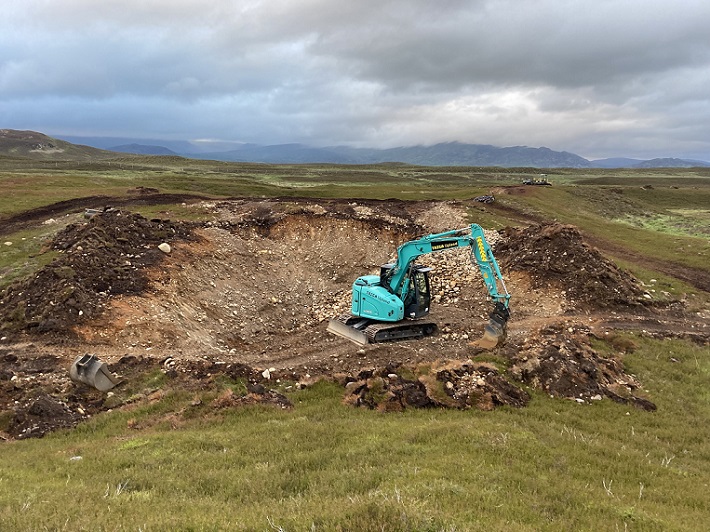
On 18th December a planning application (see here) was submitted to Highland Council on behalf of Akre Ltd for retrospective planning permission for works they had undertaken relating to the Far Ralia hill road, confirmation that the law had been flouted as I claimed last June (see here). The application form suggests the works started on 5th June 2023. Highland Council officers then asked for further information from Akre’s agent before the Cairngorms National Park Authority (CNPA) decided to call-in the application at the start of April
The planning paper are now on the CNPA’s planning portal (see here). On 29th April they published a letter from Akre’s agent, a Passivhaus Designer who appears to have designed the new bothy near the top of the “improved” hill road, requesting to speak to the Planning Committee:

The implication of the application being “relatively straightforward” is that CNPA officers have already decided what to do and, what is more, told the applicant this. This post will explain why CNPA Board Members need to treat this retrospective application as being anything but straightforward and that the information provided on behalf of Akre Ltd to support the application is both incomplete and highly misleading.
A recap of the planning history
In December 2022 SAC Consulting submitted a prior notification that it wished to upgrade 4460m of hill road from Milton of Nuide (opposite Newtonmore) to the ford at Allt Ghiubhais, mainly across land owned by the Ralia Estate, and to undertake more minor repairs to the road from there to the slopes of Garbh-Meall Mor, on land bought by Standard Life/Abrdn (see here), a further 1530m (total 5930m). The justification for the road upgrade was to enable the new owners, Abrdn, to plant trees on Far Ralia for carbon offsetting purposes. The Ferret recently revealed that Abrdn (see here) boosted its investment in fossil fuel firms last year while claiming £millions of public money for projects such as this. Abrdn is a big organisation and perhaps one half doesn’t know what the other is doing?
Initially the CNPA, which has a policy presumption against new hill roads, decided the proposals raised issues of importance to the aims of the National Park but then almost immediately reversed its position and decided to leave matters to Highland Council. Highland Council then appears to have decided the proposed works were so minor – repairs not an upgrade – that apart from the new bridge by the old Wade’s bridge, they did not even need to be considered under the Prior Notification system for forestry roads.
Highland Council did, however, make clear their position in writing at the start of May 2023:
“The agent has supplied details of the works proposed to the existing tracks and no upgrading or increasing of width of the tracks are proposed, only the finish to the track surface. These works are not considered to be part of this Prior Notification and will be treated as repairs to existing tracks. The agent has been informed that any increase in width or additional engineering works will require a full planning application to be submitted in order that the works can be carried out.”
Either the claim made by Akre and their agents that only minor repairs were planned was a lie or they almost immediately changed their mind without informing Highland Council because by the end of June track widening was clearly underway (see here). On 29th June I wrote to the CNPA and Highland Council asking them to investigate the unlawful works and referring them to the evidence published on parkswatch. The CNPA agreed to look into the matter and then on 7th July confirmed there were issues of concern. Since then I have been told nothing, not even that this “relatively straightforward” retrospective planning application had been submitted.
The CNPA’s response to the works – allow them to continue!
Last July the CNPA informed me they were having discussions about whether they or Highland Council would take the lead in responding to the unlawful works. The decision to call in the retrospective planning application strongly suggests that it was agreed they should lead on this matter. The appear, therefore, responsible for what happened since then.
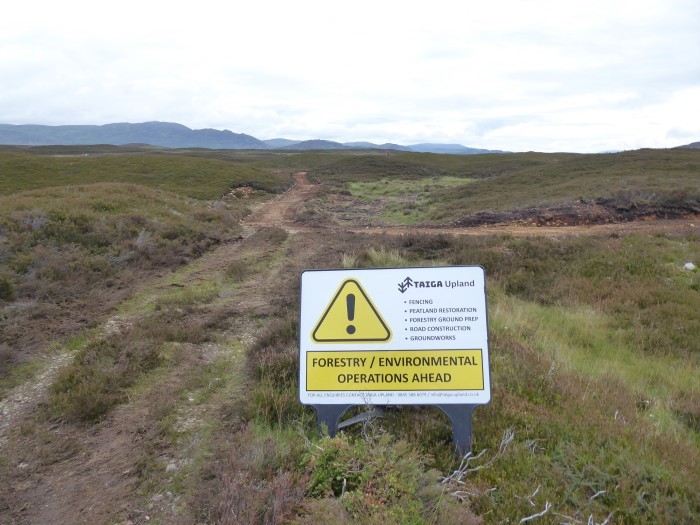
When I walked the road ten days after these communications with the CNPA, work was still in progress to widen the whole of the lower section to the Allt Ghuibhais (“river of the pine trees”). Although unlawful, one could understand why neither planning authority would want to stop work that was well underway because of the potential risks of erosion to unfinished surfaces:
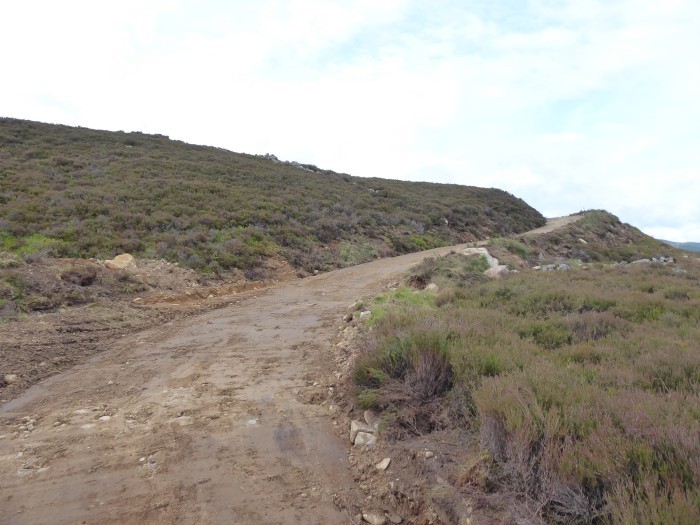
No work, however, had been started on the section of road beyond the Allt Ghuibhais but blue markers had been put in place suggesting work was planned:
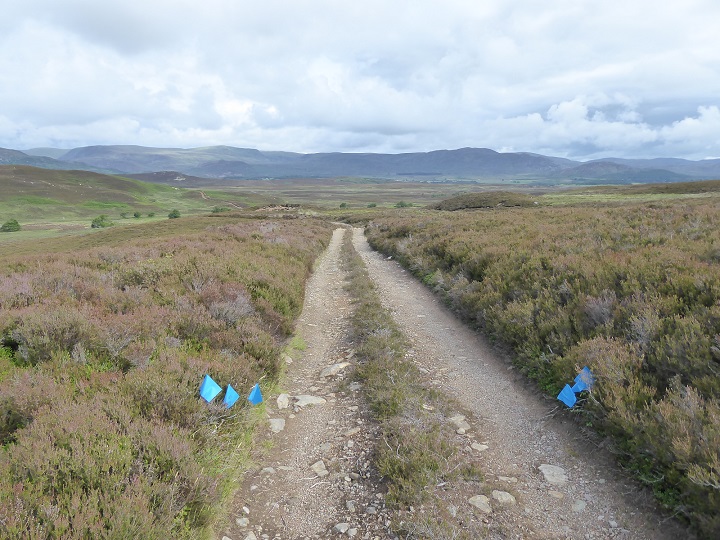
The CNPA could therefore have made it very clear to Akre Ltd, their agents and the contractors that the works that they had started should go no further than the Allt Ghuibhais. They could have also used their enforcement powers and issued a stop notice to this effect. They failed to do so.

Akre Ltd proceeded to widen the upper section of road, the one which it was originally claimed would only require minor repair works such as filling in of potholes. That is best described as lifting two fingers to planning law and the CNPA.

Not only that, but Akre Ltd had bulldozed a laydown area next to the widened road which had not been mentioned previously but which the plans in the application (see below) describe as an existing borrow pit. When I visited in January the containers were surrounded by litter:

This failure of the CNPA to respond appropriately and prevent further development, at least until plans had been submitted, raises questions about their interests in this road.
The CNPA has targets for both woodland expansion and peatbog restoration. Had the CNPA stopped the road improvements beyond the Allt Ghuibhais when it had the opportunity to do so last June, it probably wouldn’t have affected the ability of Akre Ltd to bring in diggers to cover Far Ralia with mounds for planting trees as they were driving all over the moor anyway:
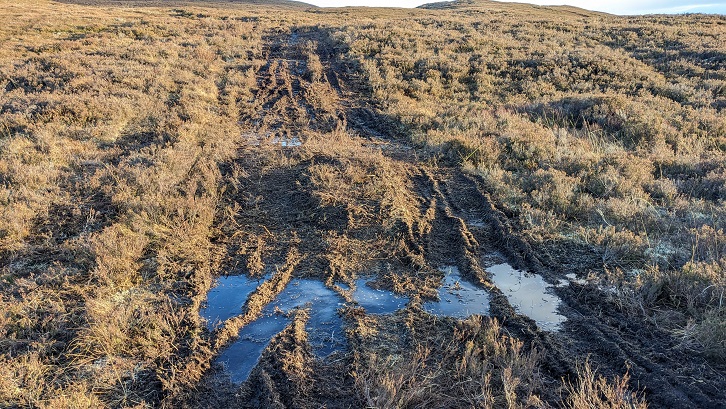
Both Akre Ltd and Abrdn, however, have publicly stated that peatbog restoration work is planned at Far Ralia. Although no plans have been submitted as yet, much of which is likely to be in the area at the top of the new road where some of the peat bog has been artificially drained. It would have been very difficult to get the machinery required for peatbog restoration purposes up the existing road and the alternative would have been to drive it across the planted moor. Hence, upgrading the road was essential if the peatbog restoration is to go ahead in future and, unlike a road purely for forestry purposes, would have required full planning permission.
The CNPA has a significant interest in this because it not only funds the peatbog restoration projects in the National Park, it also has Scottish Government targets to meet.
Other interests at play
Whether Abrdn was aware that Akre had ignored Highland Council’s instructions that any road widening needed planning permission is unclear but they should now be asking in whose interests Akre was acting?
As explained previously, Renwick Drysdale, the owner and manage of Akre Ltd, is the nephew of Alastair Findlay, a trustee of the Ralia estate who is named as the landowner contact on the retrospective planning application form. It appears inconceivable that the road widening and unlawful borrow pits took place without his consent, although whether he was aware of what Highland Council had said about planning permission being needed for anything other than minor repairs is unclear.
The retrospective planning application

The documentation in the retrospective planning application lodged on behalf of Akre Ltd is not fit for purpose. The Supporting Statement should have set out the reasons for the application, its location and design, its impact on the natural environment and what restoration was proposed but instead consists of one brief letter (see here) elicited by Highland Council. In summary it estimates c100 tonnes of material has been extracted from borrow pits, that the site covers 1.5ha and says nothing about the impacts of the development.
On 1st April the CNPA published a response from their ecology officer which confirms this, stating that there is no information in the application about the impact of the road enlargement on birds/other species or habitats and that they were therefore unable to comment. That is despite Abrdn deciding not to plant the lower plant of Far Ralia and moving a stock fence up the hill because of the importance of the area for rare breeding birds! As for habitats, as I showed last August (see here) , the largest new borrow pit had a significant impact on peat.
Given this, it is extraordinary that on 1st April the CNPA also published a Screening Opinion stating an Environment Impact Assessment was not required. The CNPA should have considered the need for an EIA last July, when the unlawful works were brought to their attention, not AFTER the planning documents had been submitted. This confirms the planning shambles. It also appears to be a case of the CNPA retrospectively trying to cover its own back, just as the Loch Lomond and Trossachs National Park Authority tried to do with the Hunter Foundation application at Ross Priory (see here).

Some of the documentation that has been submitted with the retrospective application is inaccurate. While there may have been a small borrow pit where the storage units are now located, it was small enough to walk past without noticing compared to the large area that has now been flattened (see photo above). I also have two photos of recently worked borrow pits NOT marked on the map above (there may be more!):
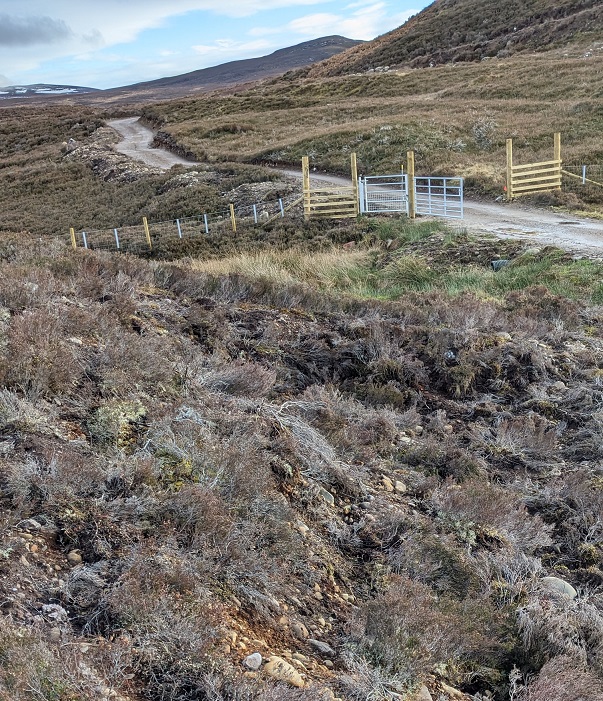
One wonders whether the passivhaus designer who submitted the application ever walked the site or whether they relied on information supplied by Akre Ltd? Why too are SAC consulting, who submitted the original Prior Notification Plans for the road, no longer involved?

There is nothing in the planning application about the banks along sections of the road or the new culverts beneath it, let alone any consideration of their design or their impact on the ecology of the area.
The application contains a limited number of images, most of one particular borrow pit next to the road, purporting to show before and after:


Even if you believe the construction of a much larger borrow pit and the consequent alteration landforms was justifiable if it it meant the smaller borrow up previously excavated by the landowner would be covered up, serious issues remain to be addressed. The restoration of vegetation is far from complete.
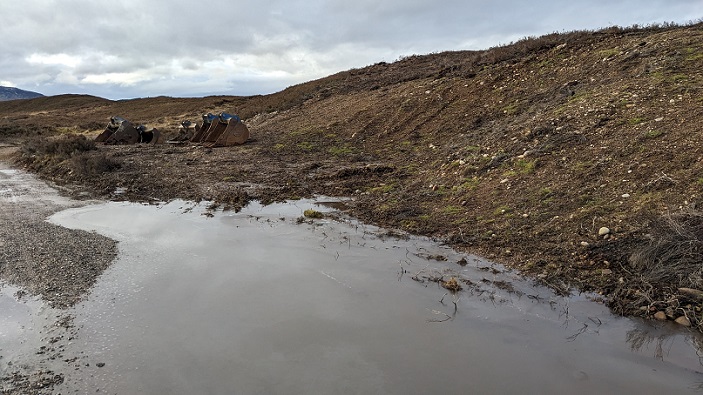
And as you can see a new problem has been created, the lower part of the borrow pit/road now gets flooded.
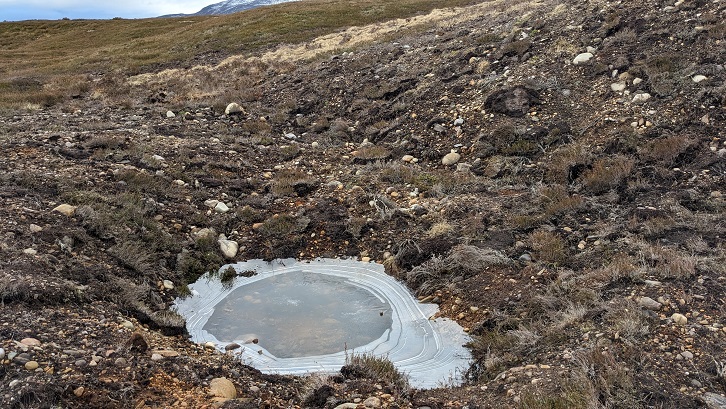
As is normal in hill road construction, due to an absence in monitoring, vegetation when removed is rarely stored properly so there is insufficient to re-cover the ground when work is finished. That also has the potential to alter the ecology of the moor.

There is no mention or evidence provided of any of this in the planning application. Is the applicant hoping neither the planners nor the CNPA ecologists will visit the site?

In fact, the smoothing of the road surface and the removal of natural bumps which used to hold the water has had fairly immediate and disastrous consequences as this photo shows. Water is now able to fun down long sections of road washing the new surface away. In two years time it appears likely very little will survive – a good example of unsustainable development in the National Park.

As for resurfacing the existing road as it ran across the low ground by the Allt Ghuibhais that appears to have been plain stupid – as soon as the river flooded the improvements were washed away.

What needs to happen
I hope I have demonstrated with this post that the CNPA’s Planning Committee should be treating this retrospective planning application as far from straightforward.
First it needs to address the CNPA’s conflicts of interests in this case and investigate whether the Park’s failure to take enforcement action was linked to its own interests in seeing peatland restoration go ahead on this site.
Second, it needs to address the failures in the design of road, the poor restoration to date and the impact that this is having on the natural environment and wildlife. It is not in the public interest for planning officials to say they will address the problems relating to the new road through planning conditions. The CNPA should be requiring Akre and its agent to provide full restoration plans before the application is considered by the Planning Committee and explain how, for example, they will reinstate a vegetated strip down the middle of the road (which would reduce water run-off and erosion) without creating more damage elsewhere.
Third, I believe the CNPA needs to address the issue of who pays to restore the damage. While the evidence suggests that primary responsibility for the unlawful improvement works lies with Akre, there are questions about both the responsibility of Abrdn and the contractor for what has happened. The dispute between the Pitmain Estate and the contractor over the River Gynack flood channel above Kingussie (see here) delayed repairs there for several years – the CNPA Board has never investigated or tried to learn any lessons from that. They should do now.
After all the adverse publicity Abrdn has received about greenwashing, the least they could do now is to guarantee to restore all the environmental damage that has been caused at Far Ralia if they cannot hold their contractors and sub-contractors to account.
This post raises the fundamental question – why was this forestry scheme given approval by Scottish Forestry? Just like the BrewDog scheme near Aviemore it is a demonstration of the £millions of public money that are currently being wasted by the Scottish Government on this type of forestry scheme. SF completely ignored the representations made to them on both these schemes to the effect that natural regeneration, not planting, should be the best method for woodland expansion in this part of the national park. Instead we have this massive, unnecessary impact on the once beautiful ancient Wade’s Road, followed by Abrdn churning up huge areas of peaty moorland in one of Scotland’s greatest greenwashing exercises in tree planting. Carbon from the churned up peaty ground will be released into the atmosphere for decades to come, along with all the carbon release that Abrdn is responsible for through its disastrous investment policies, boosting the profits of the fossil fuel companies in the USA. Scotland’s next First Minister needs to get a grip on this scandalous public funding of environmental damage in the heart of the Cairngorms National Park.